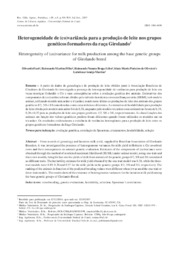Heterogeneidade de (co)variância para a produção de leite nos grupos genéticos formadores da raça Girolando.
Heterogeneidade de (co)variância para a produção de leite nos grupos genéticos formadores da raça Girolando.
Author(s): FACO, O.; MARTINS FILHO, R.; LOBO, R. N. B.; OLIVEIRA, S. M. P. de; MARTINS, G. A.
Summary: Resumo: A partir de dados de genealogia e de produção de leite obtidos junto à Associação Brasileira de Criadores de Girolando foi investigada a presença da heterogeneidade de variâncias para produção de leite em vacas mestiças Holandês x Gir e suas conseqüências sobre a avaliação genética dos animais. Estimativas dos componentes de (co)variância foram obtidas pelo método da máxima verossimilhança restrita (REML) sob modelo animal, utilizando modelo unicaráter e tricaráter, sendo neste último as produções de leite dos animais dos grupos genéticos 1/2, 5/8 e 3/4 consideradas como características diferentes. A estimativa de herdabilidade para produção de leite obtida pelo modelo unicaráter foi de 0,31, enquanto pelo modelo tricaráter estas estimativas foram de 0,19, 0,26 e 0,37 para as produções de leite nos grupos genéticos 1/2, 5/8 e 3/4, respectivamente. As classificações dos animais em função dos valores genéticos preditos foram diferentes quando foram utilizados os modelos uni ou tricaráter. Os resultados evidenciaram a existência de variâncias heterogêneas para a produção de leite entre os grupos genéticos formadores da Raça Girolando. [Heterogeneity of (co)variance for milk production among the base genetic groups of Girolando breed]. Abstract: From records of genealogy and lactation milk yield, supplied by Brazilian Association of Girolando Breeders, it was investigated the presence of heterogeneous variances for milk yield in Holstein x Gir crossbred cows and their consequences on animals genetic evaluation. Estimates of the components of (co)variance were obtained through the method of restricted maximum likelihood (REML) under animal model, using one-trait and three-trait models, being the last one the yields of milk from animals of the genetic groups 1/2, 5/8 and 3/4 considered as different traits. The heritability estimate for milk yield obtained by the one-trait model was 0.31, while the threetrait models were 0.19, 0.26 and 0.37 for the milk yields in the genetic groups 1/2, 5/8 and 3/4, respectively. The ranking of the animals in function of the predicted breeding values were different when it was used the one-trait or three-trait models. The results showed the existence of heterogeneous variances for the lactation milk yield among the base genetic groups of Girolando Breed.
Publication year: 2007
Types of publication: Journal article
Unit: Embrapa Goats & Sheep
Keywords: Cruzamento, Gado Gir, Genética animal, Herdabilidade, Produção leiteira, Seleção
Observation
Some of Embrapa's publications are published as ePub files. To read them, use or download one of the following free software options to your computer or mobile device. Android: Google Play Books; IOS: iBooks; Windows and Linux: Calibre.
Access other publications
Access the Agricultural Research Database (BDPA) to consult Embrapa's full library collection and records.
Visit Embrapa Bookstore to purchase books and other publications sold by Embrapa.

